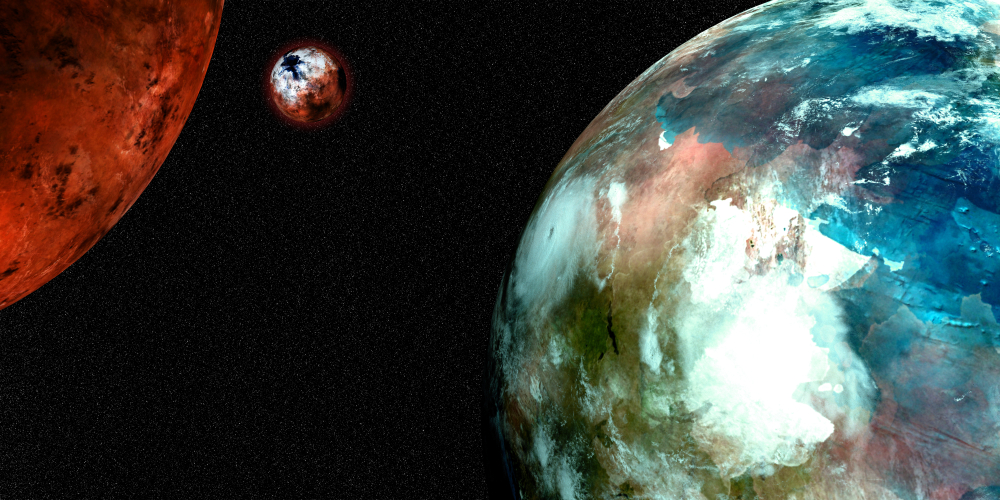EU-funded researchers are developing a powerful new telescope that will help discover Earth-like planets around distant stars and advance the search for extraterrestrial life.
Among the billions of galaxies and stars in the universe, Earth is the only place where life is known to exist. But the desire to discover other living worlds has led scientists to pursue smarter methods of exploration.
Despite the cataloging of about 6,000 exoplanets, no Earth replica – a similarly sized planet orbiting a sun-like star in a similar position to ours – has yet to be identified. This is not for lack of effort. Rather, it reflects the challenges that come with it.
Scientists have discovered rocky planets the size of Earth around smaller red dwarf stars, but planets around Sun-like stars are much harder to detect because they appear relatively small relative to their brighter hosts. But a new telescope could help researchers in this search.
Doing so could further expand the search for habitability in the galaxy. We know that Earth is just the right size and distance from its host star to support water and life. Is it the same elsewhere?
cut noise
Dr. Nuno Santos, Portugal’s leading astrophysicist and a driving force behind exoplanet exploration in Europe, is leading a team of EU-funded researchers developing new observation tools. They help block interference caused by the distant fiery “sun”.
One of the main hurdles is the “noise” produced by stars such as the Sun.
The stirring of the plasma and changes in the magnetic field at its surface produce a series of phenomena in the star’s atmosphere, including dark spots and “grainy” patterns, much like the rotational boiling of water. This obscures the faint signal that a planet is passing in front of its star.
“If you look at the surface of the sun, it looks like a pot of boiling water, with dark patches and bright patches,” Santos said. “The big problem is that we don’t really know how to diagnose this noise coming from stars.”
Santos and his team, based at Portugal’s Institute of Astrophysics and Space Sciences, are building a brand new telescope called PoET (Paranal Solar Espresso Telescope) as part of an EU-funded initiative named FIERCE that will last until September 2027.
The compact instrument, just 60 centimeters in diameter, is bound for Chile and will operate alongside the European Southern Observatory’s Very Large Telescope (VLT), located in the mountains of the Atacama Desert.
Rather than tracking planets around distant stars, PoET focuses on our Sun and analyzes the noise produced by granulation and related processes.
The solar telescope will be connected to another space exploration instrument located in Chile, ESPRESSO (Echelle Spectrograph for Rocky Exoplanets and Stable Spectroscopic Observations). It separates starlight into different colors and is specifically designed to study planets orbiting distant stars.
“By linking ESPRESSO to solar observations, we hope to understand exactly how the sun is behaving in different regions,” Santos said.
This provides a detailed spectrum of chemical elements coming from the Sun and reveals how they change as they move across the surface. Ultimately, these discoveries will help astronomers filter out noise from observations of other Sun-like stars, making it easier to detect distant Earth-like planets.
Preparing PLATO
Observations by PoET are scheduled to begin by the end of 2025 and continue for three years. The telescope uses an optical configuration that blocks all but the part of the Sun it studies.
PoET will conduct daytime observations using ESPRESSO, which Santos will remotely operate from Porto. At night, ESPRESSO will return to the center stage along with VLT.
This groundwork is especially important as the European Space Agency prepares for the PLATO (PLANetary Transits and Oscillations of Stars) mission to be launched in 2026.
The PLATO space telescope will use 26 cameras to focus on Earth-like worlds around stars like the Sun and explore planets orbiting around a million stars. The instrument measures the radius of each planet, allowing scientists to determine its density and composition over hundreds or thousands of light-years.
Reducing stellar noise through PoET is essential for PLATO to make accurate measurements. “We need to find a way to filter out this noise so that we can make the most of the data from future PLATO missions,” Santos said.
“Our hope and expectation is that PoET will learn enough to be able to reduce the noise to the required level.”
A bold move in the search for Earth-like planets
FIERCE and PoET exist thanks to support from the European Research Council (ERC). “We couldn’t do this without ERC,” Santos said.
Thanks to his team’s research, missions like PLATO promise exciting new discoveries, and Europe can play a key role in the global search for habitable worlds.
If all goes according to plan, PoET could deliver results by mid-2026 and provide important data to PLATO after launch.
Further down the line, missions such as NASA’s Habitable World Observatory, expected in the 2040s, and the next European Large Telescope, expected to be completed by 2030, will directly image some of the potentially habitable planets discovered by PLATO and look for signs of life.
But first, astronomers must discover how many such worlds exist and where to find them. “The search for Earth-like planets orbiting other suns is one of the big questions we have,” Santos said.
Telescopes like PoET and PLATO will push the boundaries of what is possible in our exploration of space. Their advances will deepen our understanding of the universe, revealing the possibility of life in our galaxy and far beyond our homeland.
The research for this article was funded by the EU’s Horizon program. The views of the interviewees do not necessarily reflect the views of the European Commission.
This article was originally published in Horizon, EU Research and Innovation Magazine.
Detailed information
Source link

